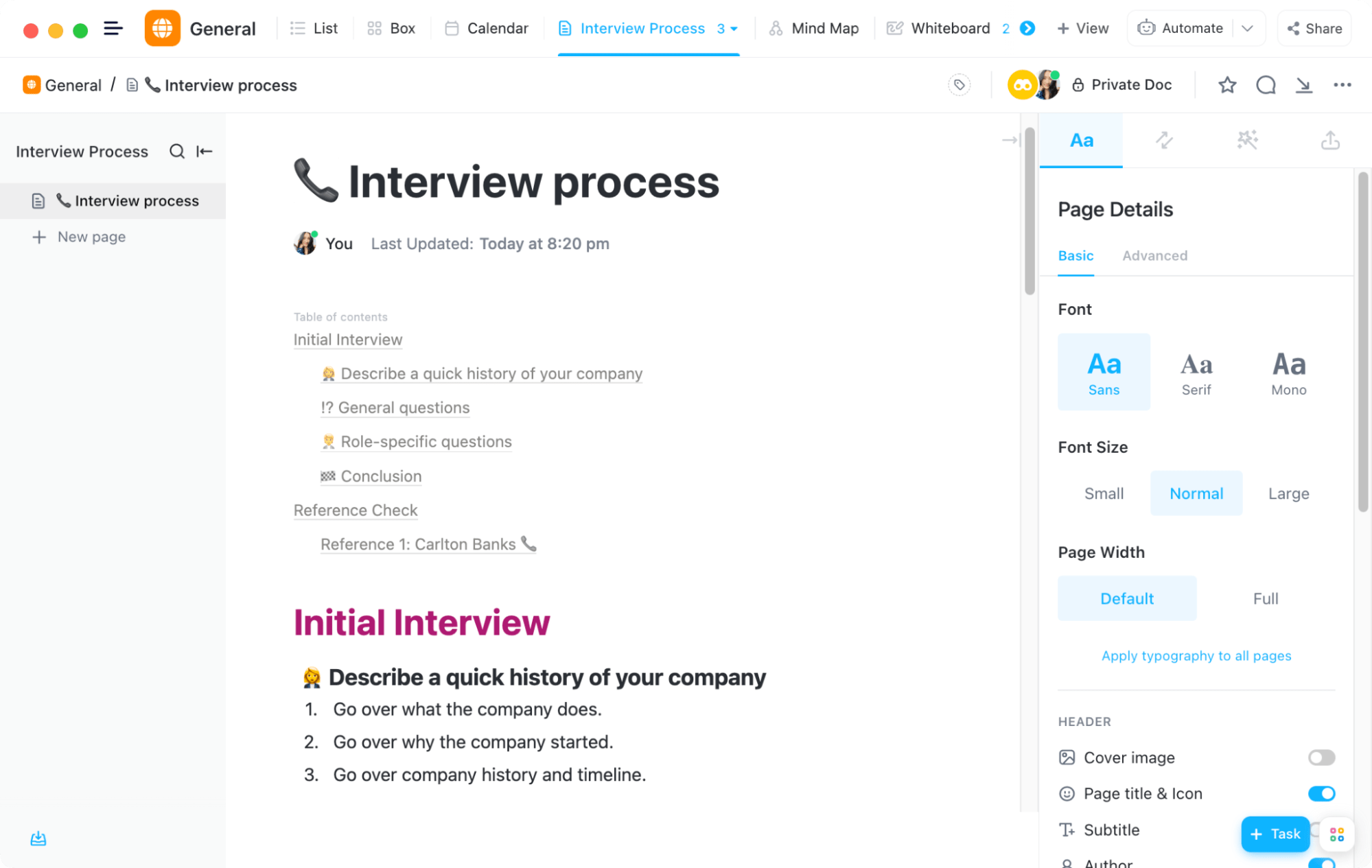

The success of any technology-backed enterprise today hinges on having a talented and capable team for software engineering. However, assembling an A-team involves a strategic approach to hiring software developers. You need an eye for talent while picking out niche roles. At the same time, you need to keep the larger software development objective in perspective.
To develop high-quality software, you must build a team with complementary technical skills while focusing on soft and interpersonal skills.
This guide on how to hire a software engineer can get you one step closer to this goal.
- Why Hire a Software Engineer?
- Signs You Need to Hire a Software Engineer
- Common Skills & Qualifications to Look for in a Software Engineer
- How to Hire a Software Engineer: A Comprehensive 14-Step Guide
- Step 1: Identify software development project needs
- Step 2: Craft a comprehensive job description
- Step 3: Check your talent reserves
- Step 4: Post on online job portals
- Step 5: Engage with the tech community
- Step 6: Shortlist the eligible candidates
- Step 7: Implement a rigorous screening process
- Step 8: Assign a technical proficiency test
- Step 9: Conduct formal interviews
- Step 10: Assess cultural fit
- Step 11: Check references
- Step 12: Make a competitive offer
- Step 13: Provide a structured onboarding
- Step 14: Collect feedback on the hiring process
- Software Engineer Hiring Templates
- How to Set Up New Software Developer Hires for Success
- Recap: Hiring Software Developers
Why Hire a Software Engineer?
Let’s start with the basics—what do you need a software engineer for?
Although this depends on the nature of your company and projects, here’s a high-level overview of what software engineers bring to the table:
- Technical expertise: Software engineers are skilled professionals with a deep understanding of programming languages, software development methodologies, digital frameworks, and the latest technologies. This knowledge is instrumental in building, maintaining, and enhancing the digital ecosystem of an organization
- Innovation: Software developers are often the brains behind innovation and technological advancements. Whether building a solution from scratch or enhancing an existing one, they help businesses stay competitive by upgrading their tools and technologies
- Problem-solving mindset: Their technical and analytical skills make software engineers natural problem solvers. Their innately logical, systematic, and structured approach makes them an invaluable asset in resolving technical issues to drive productivity and efficiency
- Product development: Whether you’re in the business of developing software products for clients or wish to create a bespoke solution for specific business needs, you’ll need a software developer. They play a crucial role through the development cycle, from initial design to development, testing, deployment, and maintenance
The above list is indicative and by no means expansive since deliverables can change depending on the goals set for software engineers.
Signs You Need to Hire a Software Engineer
Sure, software developers have a lot to offer. But how does their expertise align with the overarching organizational goals? How do you know when you need to hire a software engineer?
To help you answer these questions, we’ve compiled signs that indicate it is time you hired a software developer:
- The existing team is consistently overloaded with work and displays signs of burnout
- Delays in project timelines due to issues like resource unavailability or other constraints
- Frequent bugs, errors, or performance issues that indicate a skill gap
- Inflexible software solutions that are unable to scale as per business demands
- Use of legacy systems or outdated technologies that hinder performance or security
- Non-tech teams bearing the workload for tech-related issues
- High turnover rates in the development team followed by a lengthy recruitment process
- Lack of innovation jeopardizing business in terms of product, features, or performance
The above symptoms must activate your hunt for software development talent, either in an individual or a team, to address these challenges before they compound.
Common Skills & Qualifications to Look for in a Software Engineer
Once you recognize the need to hire software engineers, identify the skill gaps or any other requirements. This analysis will provide visibility into the skills and qualifications that can be added to the job description during the requisition process.
To give you an idea of the various parameters required, use the following list of common software engineering skills and qualifications as a reference:
Technical skills
The software developer’s technical skills may vary depending on the development environment. But you’ll typically look at:
- Programming languages: Technical proficiency in one or many programming languages, such as Java, JavaScript, C++, Python, Scala, etc. It should align with the programming languages used in your tech stack
- Object-oriented design (OOD): Grasp of OOD concepts like encapsulation, abstraction, inheritance, generalization, and decomposition
- Web development: Knowledge of front-end, back-end, or full-stack web development technologies, frameworks, and libraries
- Database management and administration: Familiarity with database management systems such as MongoDB, PostgreSQL, MySQL, etc.
- Version control: Experience working with version control systems like Git for collaborative coding
- Software development methodologies: Understanding of Agile, Scrum, DevOps, or any other software development methodologies
- Testing and debugging: Ability to write unit tests, pen test applications, perform code reviews, and conduct debugging
- Cloud computing: Hands-on knowledge of cloud platforms such as Google Cloud, AWS, and Azure
- Mobile development: Ability to develop mobile apps for different operating systems like iOS or Android using Swift and Kotlin or Java, respectively
Feel free to handpick the technical skills and software development tools that match the project requirements.
For instance, developing apps for mobile devices would require proficiency in programming languages like Swift, Kotlin, or Java, paired with knowledge of mobile development frameworks like React Native, Flutter, or Xamarin.
In contrast, the technical skills needed to customize a cloud-based CRM platform involve familiarity with the cloud environment, API customization, scripting languages, integrations and webhooks, and more.
Soft skills
Software engineers rarely operate in a vacuum. Considering that they may work with a team or engage with internal or external stakeholders, you would expect them to possess the following soft and interpersonal skills:
- Problem-solving: An analytical mindset alongside creative thinking to resolve complex problems
- Attention to detail: Thoroughness in documenting, coding, and testing practices to ensure product quality
- Communication: Communication and collaboration skills to comprehend and articulate the software project specifications, work with team members, and engage stakeholders
- Team spirit: The ability to fit cohesively in a team setup and collaborate with others to contribute to shared goals
- Time management: Manage time effectively to meet project milestones and deadlines as per a set schedule
- Willingness to learn: Ability to adapt and pivot strategies or incorporate up-and-coming technologies, such as using AI tools for developers to enhance software quality
Qualifications
Here’s where you’ll look for specific qualifications such as:
- Education: A higher degree or bachelor’s in computer science, software engineering, or a related field, though not mandatory, is preferable
- Certification: Relevant software development and programming certifications such as AWS-certified DevOps Engineer, Certified Kubernetes Application Developer (CKAD), etc. to demonstrate specialized expertise
- Work experience: Portfolio to display prior experience working on multiple projects, specifically ones similar to the present requirement
- Community involvement: Participation in online forums for software engineers or professional development workshops, events, and conferences
By carefully mapping the technical skills, soft skills, and qualifications outlined above, you can develop a comprehensive profile or job description for an ideal software engineer matching business requirements.
Remember, this template is simply a starting point—tailor it to your unique project requirements, tech stack, industry standards, company goals, and the ever-changing world of technology.
How to Hire a Software Engineer: A Comprehensive 14-Step Guide
Now that you’ve laid the groundwork for hiring software engineers, it is time to dive into the process. What follows is a detailed step-by-step guide on how to hire software engineers.
Step 1: Identify software development project needs

Assessing the software development project’s requirements is the first and crucial step of the hiring process. It will involve taking stock of the project requirements along parameters like:
- Scope
- Objectives
- Technical requirements
- Deliverables
Ensure that these elements illustrate the project complexities and risks or challenges while also quantifying desired outcomes and their corresponding standards.
Next, involve the project manager and existing team members to identify:
- Required skill sets
- Existing software development tools or methodologies
- Mission-critical technology
Compare your existing team’s composition and capabilities to identify any skill gaps the new hire could address.
In some cases, you may discover a future requirement or a more qualified substitute to expand capabilities. For instance, hiring a full-stack software engineer may be more beneficial, even if the current project requirement revolves around backend development. Maintaining flexibility to incorporate such long-term goals extracts more value from the current hire rather than redoing the whole cycle.
Such a well-rounded assessment of the software development project’s needs allows hiring managers to identify candidates who meet immediate as well as long-term requirements.
Step 2: Craft a comprehensive job description
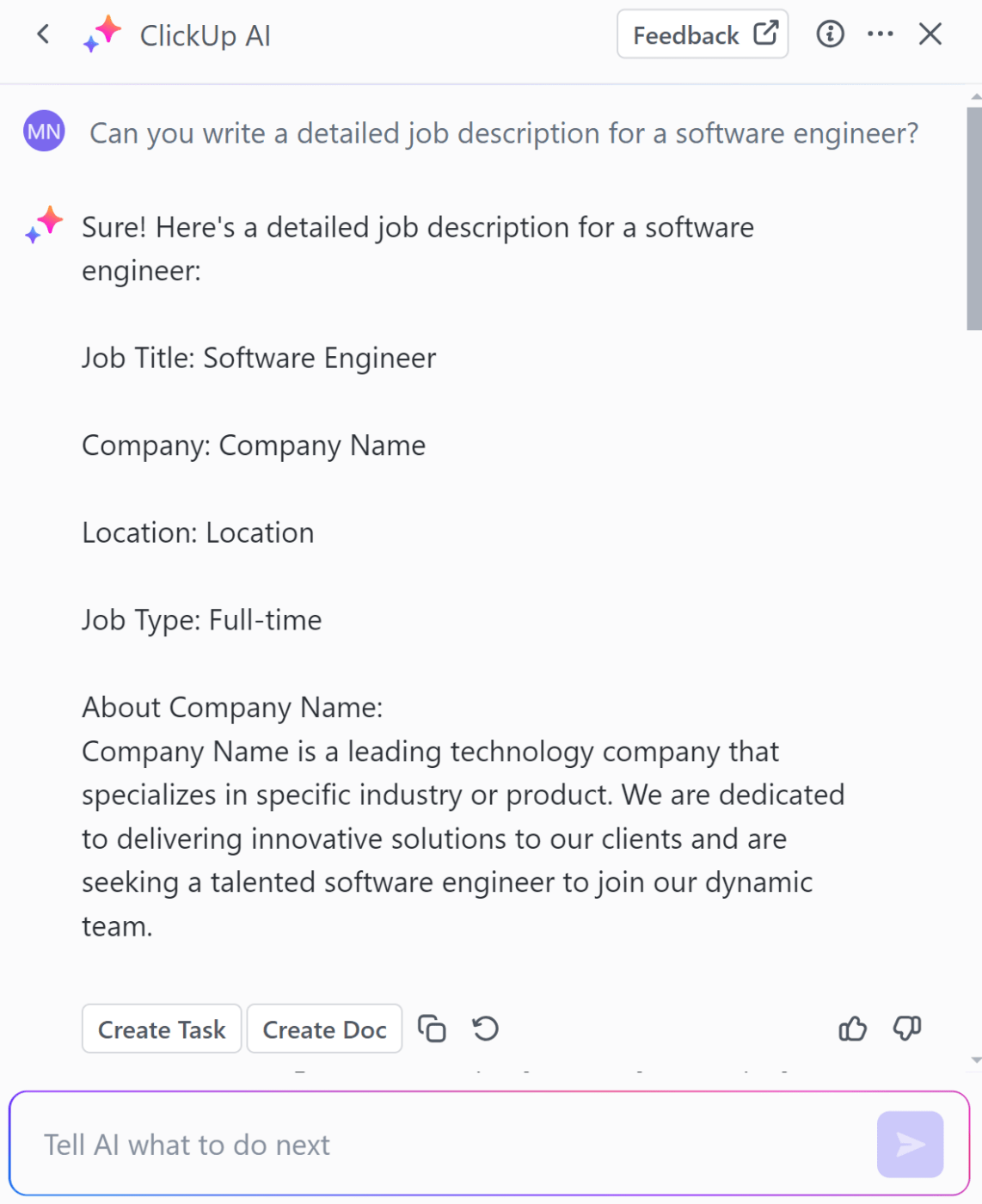
Next, translate the skill gaps and project requirements into a detailed job description.
A well-crafted job description typically includes:
- Company overview: Some background on the company’s mission, vision, and value statements
- Software engineer profile: A list of roles, responsibilities, expectations, and obligations outlining what the software developer is expected to do on a day-to-day basis
- Technical qualifications: The technical skills, programming languages, development environment, tools and technologies, software development methodologies, educational qualifications, certifications, etc., that align with the needs of the software development project
- Non-technical qualifications: Soft skills like communication, collaboration, problem-solving skills, time management, adaptability, etc., to ensure that the developer is a cultural fit
- Key differentiators: Reasons why the candidate should apply for this software developer position. For instance, you may highlight unique aspects of the job (remote working, flexible hours, company retreats, etc.), workplace certifications, and other details that may attract top talent
- Pay: Declare the pay at the outset to enable applicants to manage their salary expectations. Share a comprehensive breakdown of the pay and other allowances such as performance-linked bonuses, health insurance, ESOPs, retirement benefits, etc. Even if you’re unable to disclose a fixed amount, share a ballpark estimate
This job description will be your blueprint during talent hunting!
💡Pro tip: Use ClickUp Brain’s AI power to quickly draft job descriptions that you can then tweak to your liking
Step 3: Check your talent reserves
You may also thoroughly audit the existing talent reserves before listing the job description and commencing the recruitment process.
This stage involves:
- Revisiting profiles of shortlisted candidates from the previous recruitment cycles,
- Exploring internal candidates who are eligible for promotion and
- Leveraging internal databases to explore opportunities for internal talent mobility or development
By tapping into these reserves, organizations can cut down on hiring costs and timelines.
For example, by assessing prior applications, you’ll find candidates who have already expressed an interest in working with you and whose profiles you have already vetted.
On the other hand, internal candidates have experience and are cultural fits and will only require training and upskilling to step up from their current role to take charge as a software developer. Growing people from within also creates a culture of potential recognition and career growth, which will nurture, retain, and attract talent.
Step 4: Post on online job portals
Now comes the part where you post the job description on various job portals, specifically online portals, as they unlock the possibility of recruiting remote software engineers.
Start by shortlisting the relevant online platforms such as LinkedIn, Indeed, Glassdoor, etc. You may also explore specialized tech job boards where top software developers seek opportunities.
Check out other jobs listed on these platforms and fine-tune yours to stand out. Highlight the perks, allowances, and any standout features associated with the post, such as remote working opportunities, work-life balance, company outings, etc. Also, embed industry-specific keywords and optimize the job description for greater visibility.
Share the listing on social media platforms and other groups to amplify its reach.
Step 5: Engage with the tech community
You might find the best software developers hanging out on online forums, industry conferences, and local meetups. Making your presence felt here will help you in your search. You can also use this as an opportunity to showcase your organization as a great place to work.
At the same time, engaging with the community will update you on the latest trends in the world of technology, such as the skillset in high demand and those on the decline, while giving you an idea of the job market.
Community engagement, sharing insights, and relationship building can connect you with exceptional software developers who may not be actively looking for jobs but possess the skills and expertise you seek.
This stage is optional, but consider it an investment in making your startup a magnet for top-tier talent.
Step 6: Shortlist the eligible candidates
Once all the applications have come in, you or your team must go through them. Depending on the volume of applications, you can either do this manually or invest in an Applicant Tracking System (ATS).
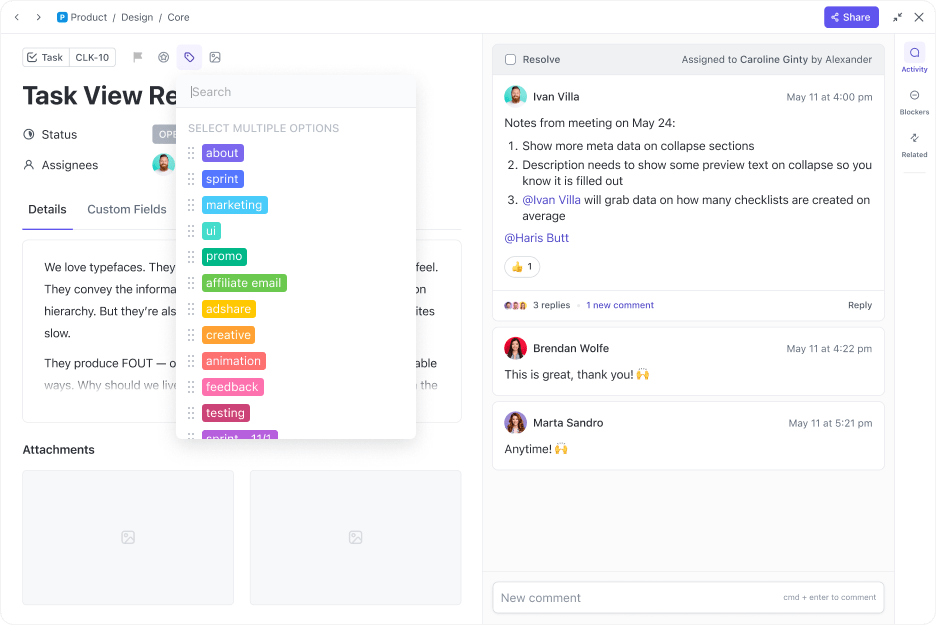
Review the resumes based on your job description. Since this is the first assessment stage of the recruitment process, focus only on aligning candidates’ professional skills, educational background, and experience with the job specifications. For example, if you’re looking for someone with 10 years of experience, a new developer with little to no experience would be a no-go.
At this stage, you want to longlist applicants who meet the fundamental criteria and should be looked into. You may also briefly read through their cover letters to get a broad idea of their communication skills, clarity of thought, and coherence in written communication.
💡Pro tip: Use Custom Fields to create fields such as ‘Location,’ ‘Current comp,’ ‘Relevant experience,’ and any other info you want to capture; add Tags like ‘Employee referral,’ ‘Eligible,’ and any others you wish to use to filter the applications.
Step 7: Implement a rigorous screening process
As the candidate pool narrows, you can dig deeper into the profiles of the shortlisted candidates.
Until now, you may have assessed the profiles quantitatively, comparing experience in the number of years or matching educational qualifications, etc. Now, you need to perform a qualitative check on each candidate and go beyond what’s in their CVs. The emphasis now is on aligning the candidate’s professional skills to the specific needs of the software engineer role.
For example, if you’re building an agile team, someone familiar with the Continuous Integration/Continuous Deployment (CI/CD) pipeline and automated deployment would be a better pick than someone lacking this knowledge.
So, schedule a preliminary phone call or online meeting to comprehend the candidate’s aspirations, experience, and motivations. Discuss the project to envision how the candidate fits the project requirements—and your organization. The objective is to get an idea of their practical experiences, problem-solving abilities, and software development expertise to conclude how they add value to the business project.
Such targeted questioning helps refine the candidate pool for subsequent stages, ensuring that those progressing are qualified on paper and in spirit.
💡Pro tip: Losing track of your schedule as you run screening calls? Sync ClickUp with your favorite calendar app (Google, Apple, Outlook, Calendly…) so you don’t miss any scheduled tasks or calls!
Step 8: Assign a technical proficiency test
Hiring managers often ask their shortlisted candidates to undergo a technical assessment to test their skills. The assessment grants an overview of the candidate’s technical abilities, reasoning and problem-solving, coding skills, and other practical aspects of being a software developer.
A holistic and well-rounded technical proficiency test typically covers the following:
- Assignments that mirror real-world problems that the software developer might encounter while working on team projects
- Theoretical questions that evaluate the conceptual understanding of software development
- Hands-on coding challenges that assess the practical application of theoretical knowledge
- Debugging exercises to evaluate the ability to identify and fix code issues
- Algorithmic problem-solving tasks to assess analytical thinking and problem-solving while designing algorithms
- Code optimization tasks that improve efficiency and documentation
- Awareness of common security threats and vulnerabilities through evaluation of security-related scenarios or best practices
Follow established assessment criteria and benchmarks to measure the candidates’ performance during this stage. However, consider acknowledging or rewarding innovation, adaptability, and an overall attitude toward problem-solving.
💡Pro tip: Create shareable assessments (and supporting material) in ClickUp Docs for one-click sharing with candidates and hiring managers and link them to your hiring workflows.

Step 9: Conduct formal interviews
After the candidates have displayed their coding skills, problem-solving abilities, and general technical competence in software engineering, it is time to test their soft skills.
Interviews are a great way to gauge a candidate’s soft skills.
Structure these interviews to be focused and comprehensive. Here’s what you can do to gain more insights through every interaction:
- Start with a basic introduction. Let the candidate highlight their key skills, competencies, past experiences, etc.
- Use the details shared above as a prompt to segue into specific aspects of the candidate that interest you. For instance, you may pick out specific personality traits or skills they have talked about and ask them to exemplify it
- Encourage them to share real-world examples that demonstrate their particular skills or personality traits
- Discuss previous projects to understand the candidate’s individual role and contributions to its success
- Ask behavioral questions to understand their collaboration styles, ability to work in teams, adaptability, and overall attitude
- Share hypothetical scenarios to gauge their decision-making or conflict-resolution skills
- Assess their understanding of emerging technologies and trends in the area of software development
- Inquire about their professional aspirations and how they see them aligning with the current job opportunity (or vice versa)
In addition to the regular answers, the candidates’ responses will give you an idea of their soft skills specific to their communication styles—their ability to articulate and express.
You can schedule multiple interview rounds with different teams to evaluate the candidate’s skills holistically. Save time by using interview templates to guide the hiring process.
ClickUp’s Interview Process Template helps you create a structured interview process. Use this docs template to assess candidates quickly and fairly, provide all candidates with a uniform interview experience, and collaborate with stakeholders through the process.
Step 10: Assess cultural fit
Whether you hire software engineers for the long run or freelance software developers on a project basis, you’ll want to retain talent until you reach these goals. For this reason, you must assess whether they are a cultural fit lest the hire result in churn.
In this stage, you assess whether the organization’s values, team dynamics, and work environment match the individual’s beliefs, expectations, and personal or professional ethos. Ideally, you will pitch questions about the candidate’s work preferences or collaboration styles during the interview to get a broad idea of whether the candidate is a cultural fit.
However, for critical roles, you might want to spend more time on this. Some hiring managers bring the candidate into the workplace for a meet and greet or have them interact with the team in a more informal setting. This allows the candidate and the team to see how they might fit together. You could schedule an online catch-up or even invite them to company events so that you and the potential candidate can gain an insight into the cultural aspect of working together.
Step 11: Check references
At this stage of the hiring process, your list of software developer prospects would have whittled down to just a few. However, before you make a choice, negotiate terms, and extend an offer, running a quick check on their references is good practice. This step will offer insights into their past performance, technical background, work ethics, teamwork spirit, and more.
Since you already have the candidate’s profile and work experience history, you can get in touch with their previous organization for a qualitative insight about their:
- Technical competence
- Reliability
- Ability to work in a team
- Time management
- Adaptability
- Responsiveness to feedback
This step would be subject to the laws around reference checks in your country and state. For instance, some organizations in the US have a legal requirement to do background checks before hiring staff, for which they also need the candidate’s go-ahead.
Step 12: Make a competitive offer
Welcome to the fag end of the hiring process—you’re almost at the finish line.
You’ve done all the talent sourcing, scouting, and vetting. It is now time to hire software engineers by offering mutually acceptable terms. Approach negotiations with transparency and a focus on mutual benefits.
Start by understanding the software engineer’s priorities. Do they value flexible work hours or remote working? Do they prioritize professional growth over financial appraisals? Get an idea of their primary motivators and see how best you can meet them
Communicate the company’s expectations and available resources and opportunities. Address both parties’ needs so that you can start this relationship on a positive note.
The best software developers often receive multiple job offers and are spoilt for choice. To ensure you can attract the best talent, keep your benefits reasonably competitive.
If everything falls in place, issue a written offer and get the contract signed!
Step 13: Provide a structured onboarding
Of course, the hiring process doesn’t end with them joining your team. A positive onboarding experience can set the stage for a pleasant working relationship.
Start with an orientation session so the software engineer knows the company policies and procedures. At the same time, share many helpful onboarding resources to facilitate a seamless transition.
Ideally, an onboarding kit for software engineers should contain the following:
- The employee handbook
- An organizational chart
- Details of the technology stack
- A project overview
- Goals of a software engineer
- KPIs for performance measurement
- Communication channels
- Access details of computer software in use
- Company swag
- Other relevant materials
You may also assign a mentor or a buddy who can help them overcome initial bumps and kindle a sense of belonging to the team.
Continue to encourage open communication, address queries or concerns, convey expectations, and discuss career development paths to engage and involve the software developer.
💡Pro tip: Let ClickUp Automations save you time through the entire hiring process. Send emails, add tags, apply templates, and assign tasks using ‘when’ and ‘then’ logic to keep your work moving automatically.
Step 14: Collect feedback on the hiring process

Capturing feedback on the hiring process helps continuously improve and optimize the cycle for future recruitment endeavors.
Implement a structured feedback mechanism that collects insights from all internal and external stakeholders involved—the candidates, the selected software developer, hiring managers, interviewers, and everyone else.
Encourage them to discuss the hiring funnel’s strengths and weaknesses and also seek input on how certain areas can be streamlined or enhanced.
Once you have all the feedback material, you can identify the recurring issues and focus on them first. This way, you will slowly improve the hiring process and attract more talent to your organization
Software Engineer Hiring Templates
Our 14-step strategy must have clarified how to tackle a task as complex as hiring the right software engineers. We’re now about to share a secret to supercharge your recruitment process and make it more efficient. We’re talking about hiring templates.
With hiring templates, you don’t have to reinvent the wheel. They provide a framework of how to go about the hiring process, with just enough room to tweak depending on your requirements. Here are a few such ready-to-use, configurable templates that can help:
Hiring candidates
ClickUp’s Hiring Candidates template streamlines recruitment through its comprehensive preconfigured tools. Whether tracking applications or organizing them by job role and skill, the template contains all you need to facilitate the process. If you’re looking for fair, consistent evaluation and efficient recruitment of the best software engineers, this template is for you!
Hiring selection matrix
ClickUp’s Hiring Selection Matrix eliminates all the elbow grease in sorting and evaluating resumes. Here, you simply need to input the candidate data along with the essential and desirable criteria for candidate selection, and the selection matrix will do all the work for you! In addition to making the decision data-driven and more accurate, this selection matrix also reduces the time required.
Recruiting and hiring
The Recruiting and Hiring template on ClickUp is a toolkit to store and organize data hierarchically and logically. You can upload resources for the internal stakeholders, track candidates, view scorecards, schedule interviews, and more. It is a perfect solution for small businesses to quickly and effectively identify a software engineer for their specific need.
Hiring checklist
The ClickUp Hiring Checklist ensures that everything runs smoothly throughout the hiring process. It is an interactive list detailing all the recruitment activities. It also has a section that you can customize and share with the newly recruited software engineer to make the onboarding process easier.
How to Set Up New Software Developer Hires for Success
Once the training and onboarding are over, you’ll want your software engineer to put in the time and effort to deliver innovative solutions. However, contrary to popular opinion, a craftsperson is only as good as the tools they use. You must also equip the software engineer with the right tools and technologies to help them achieve their goals.
ClickUp is the tool you need.
ClickUp manages to prove its mettle in software engineering projects through its following features and capabilities:
- Customizable: Design your space your way. From different project views to custom fields, the software engineer can modify the platform to match their development workflows and processes
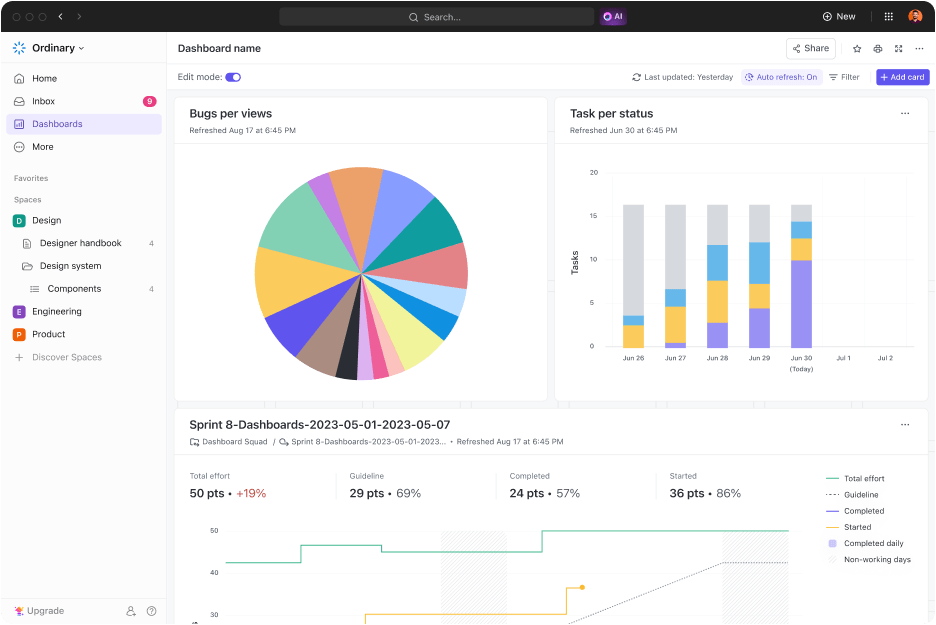
- AI-powered: ClickUp Brain is a next-generation AI assistant for ClickUp users. You can use it to create attractive hiring posts, detailed job descriptions, and summarize candidate CVs. Your software developer can also use it to write or debug codes or manage knowledge bases—the possibilities are limitless

- Automation: ClickUp Automation allows the software engineer to choose from a library of 100+ preset automations or build them from scratch depending on the needs of the development projects
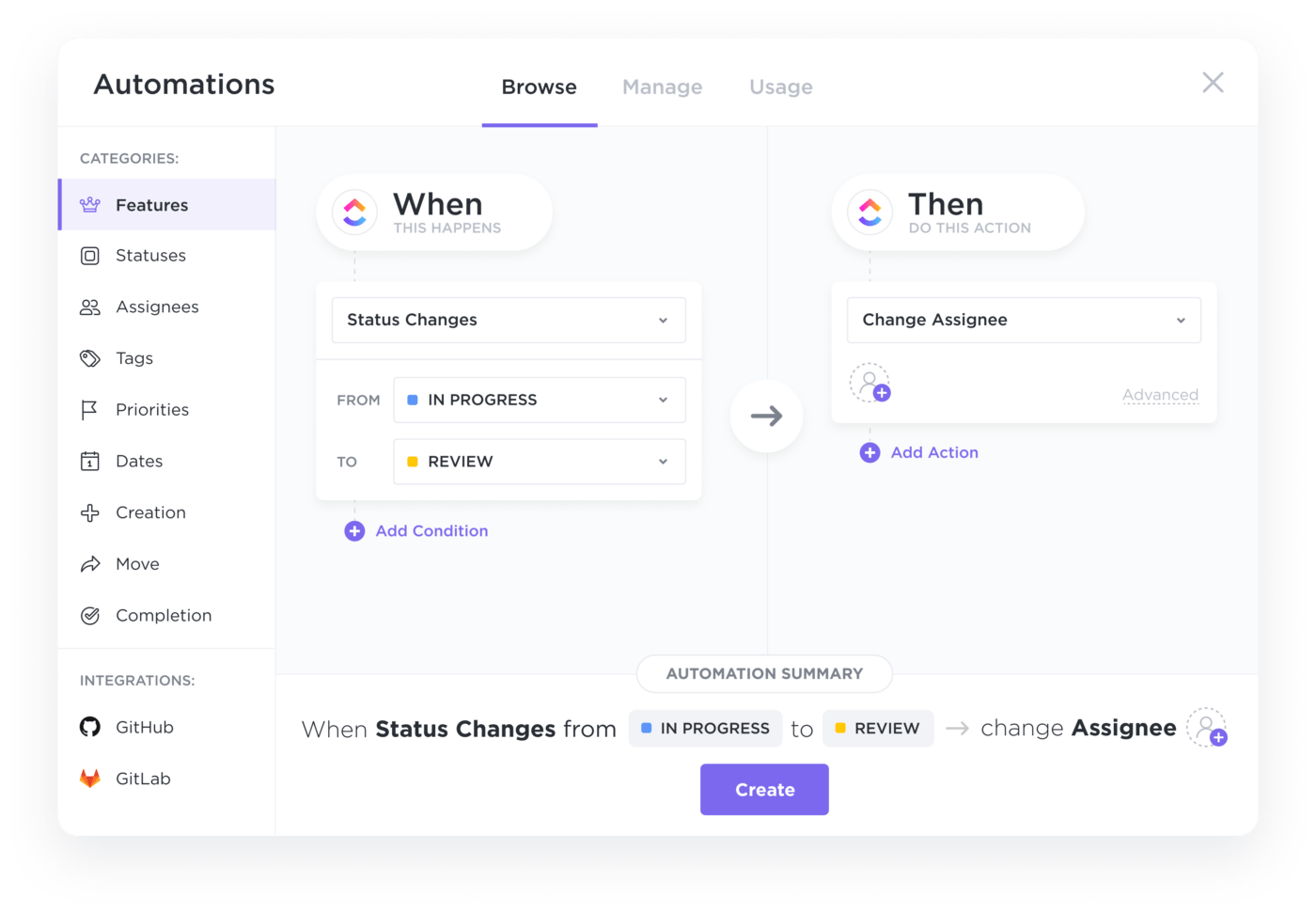
- Documentation: ClickUp Docs is a centralized repository for all documents, wikis, and more. Support your code with robust documentation with ClickUp Docs
- Collaboration: Brainstorm ideas over whiteboards, chat, or share resources in the comments. ClickUp supports collaborative working in more ways than one

- Agile methodologies: With features like custom agile dashboards, milestone tracking, sprints, etc., ClickUp makes agile development truly agile

- Integrations: ClickUp supports various integrations, such as GitHub or Bitbucket for version control, Jira or Redmine for bug tracking, Figma for web app prototyping, and more. The ability to integrate different platforms, applications, and systems with ClickUp makes it an invaluable asset for software engineers.
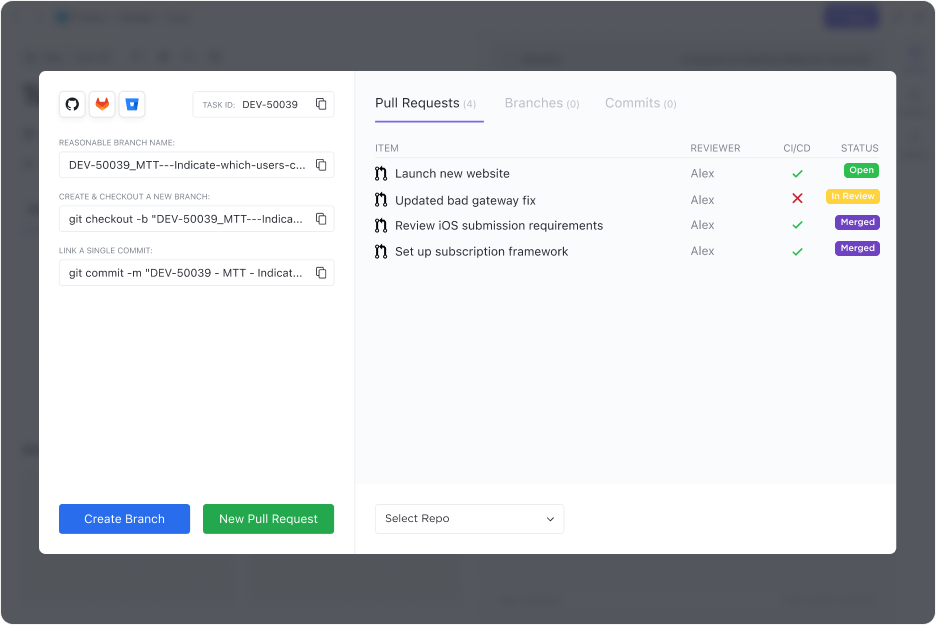
Also Read: The most useful templates for software engineers
Recap: Hiring Software Developers
- Identify requirements and skill gaps
- Create a detailed job description
- Check existing talent reserves
- Post your hiring plan online and in tech communities
- Shortlist and screen eligible candidates
- Use a technical assessment to qualify candidates for interviews
- Conduct interviews and assess cultural fit
- Check references and roll out a competitive offer
- Give them a pleasant and structured onboarding
- Use tools and templates to save time wherever you can
Tech Recruitments Made Easier With ClickUp
We hope these tips on how to hire a software engineer were helpful. While ClickUp is a powerful productivity tool for developers, it is also an invaluable asset for recruiters and hiring managers. You can use it very effectively as a recruitment tool as well.
Use ClickUp Brain to craft compelling job descriptions, Forms to capture candidate information, Documents to store all internal and external data, a Calendar to draft an interview schedule, templates to jump-start the process—the list goes on.
Moreover, you can view all the activities in a centralized space and get real-time updates on the hiring process.
So, whether you use it to hire an engineer or to support them in their job, ClickUp is all you need!
Sign up to give it a try!




